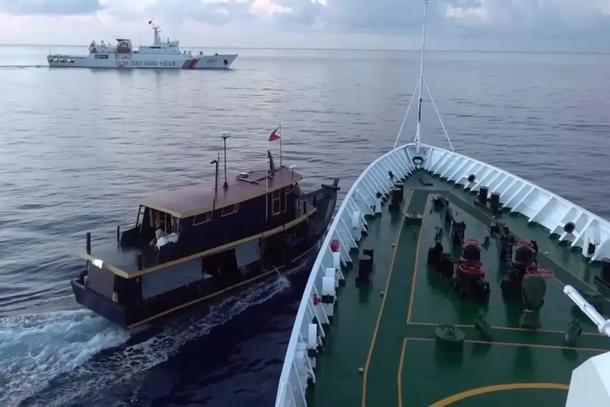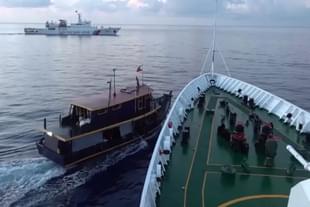World
There's A Crisis Brewing In South China Sea And India Is Not Watching From The Sidelines
Ujjwal Shrotryia
May 08, 2024, 05:41 PM | Updated 05:40 PM IST
Save & read from anywhere!
Bookmark stories for easy access on any device or the Swarajya app.


A crisis is looming in the South China Sea (SCS) as tensions escalate due to aggressive Chinese manoeuvres against various nations.
Just four days ago, on Saturday (4 May), a Chinese J-10C fighter jet, in a dangerous move, released flares in the flight path of an Australian Seahawk helicopter.
A week earlier, on 30 April, a Chinese Coast Guard vessel rammed two Philippine supply ships and sprayed water cannons at the ships' electronics, damaging their radar and satellite communication equipment.
These Filipino boats were on a supply mission to fishermen on Scarborough Shoal, which China claims as its own territory.
Furthermore, Chinese jets and bombers regularly violate Taiwanese airspace.
China claims a majority of the SCS under the imaginary nine-dash line, which it considers its de facto boundary. This, however, encroaches upon the exclusive economic zones (EEZs) of multiple nations, such as the Philippines, Vietnam, Taiwan, Brunei and Malaysia.
All these nations dispute these claims. In fact, the International Court of Justice (ICJ) in The Hague also deems these Chinese claims illegal, but despite this, China forcefully tries to enforce these claims, even to the extent of using force, as in the case with the Philippines.
It is also constructing large aircraft carriers, the most recent being the Fujian, which went on sea trials earlier this month.
From these aircraft carriers, it hopes to dominate the entire SCS and also maintain a permanent presence in the Indian Ocean, challenging India’s dominance in the region. China estimates that it will have a fleet of six aircraft carriers by 2035. Six aircraft carriers and their supporting destroyers, frigates, submarines, and other ships also need supporting infrastructure.
For this, it is expanding its port footprint by gaining access to multiple ports in various countries.
It already has a military base on the western edge of the Indian Ocean in Djibouti, operates Hambantota port in Sri Lanka, and Kyaukpyu port in Myanmar and, according to rumours, has gained access to Ream naval base in Thailand.
India, which is a principal rival of China in Asia and globally, and with which China also has boundary disputes, similar to the SCS, is not sitting on the sidelines either.
Just as China turned multiple nations in India’s vicinity against India — Maldives, Nepal, and even Sri Lanka, at one point in time, India is now reciprocating in full to China.
The most visible case is that of the Philippines, where clashes between the Chinese Coast Guard and Philippine supply ships are making headlines.
Last month, India delivered the first batch of BrahMos supersonic anti-ship cruise missiles to the Philippine Marine Corps. Moreover, India displayed its firm support for the Philippines to uphold its sovereignty against China, to which China reacted angrily by asking any third party (read: India) to not interfere in the maritime dispute.
Furthermore, India's largest commercial port operator Adani Ports and Special Economic Zone (APSEZ) is also considering to construct a large 25-metre deep port in Bataan which will be able to support large 80,000 dead weight tonne (DWT) cargo ships.
Three Indian Navy ships, including a destroyer, INS Delhi, an anti-submarine corvette, INS Kiltan, and a fleet support ship, INS Shakti, are already in the SCS where they are scheduled to exercise with the Singapore Navy.
This is particularly relevant since the Philippines, along with the US, Australia, and France, are conducting their largest-ever joint exercises, involving some 16,000 troops, in the SCS, which has irked China.
With Taiwan, which China has pledged to unify, India is strengthening its relations further.
Taiwan’s contract manufacturing giant, Foxconn, has already invested in India, from whose factories Apple products are being assembled and exported all over the world.
Taiwan is also looking to recruit Indian workers to address its labour shortages in manufacturing, construction, and agriculture. India and Taiwan signed a memorandum of understanding (MoU) for the same in February.
Just last week, Taiwan’s Labour Ministry approved this proposal.
This suggest that India is gradually shifting its approach from reactive policy-making to a more proactive stance. This also gives a warning to the Chinese — if you can play this game, we can play it too, and in your own backyard.
Also Read: BrahMos Delivery To Philippines: First Steps In Countering China In Its Backyard, Many More Needed
Staff Writer at Swarajya. Writes on Indian Military and Defence.





